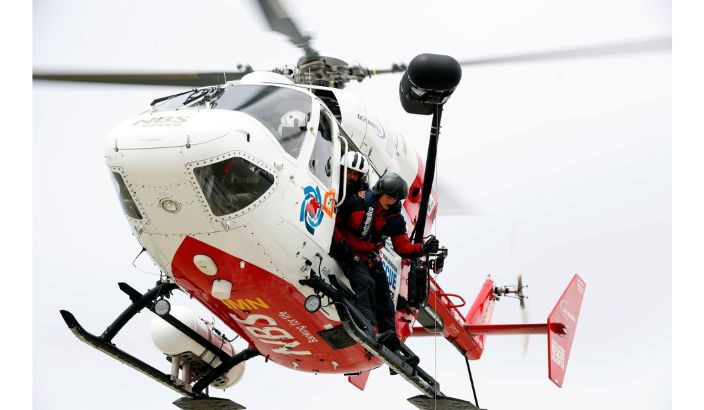When Every Second Counts


When disaster strikes in remote or rural parts of the Top of the South, the sound of rotor blades overhead has meant the difference between life and death for many. Photo: Supplied.
ADRIENNE MATTHEWS
When disaster strikes in remote or rural parts of the Top of the South, help can sometimes feel a world away but for countless people across Marlborough and Nelson, the sound of rotor blades overhead has meant the difference between life and death.
The Nelson Marlborough Rescue Helicopter Service operates around the clock, ready to respond to medical emergencies, serious crashes, and life-threatening situations across some of the most rugged and isolated terrain in the country. From mountaintops to farms, from winding coastal roads to suburban backyards, their crews deliver the critical care and speed that ground transport simply can’t match. For those who have needed it, the service is nothing short of a miracle.
Blenheim man Dave Murray knows that better than most.
What began as an ordinary day on their family rural property in the Waihopai Valley, quickly turned into a life-or-death ordeal when he suffered two heart attacks followed by cardiac arrest.
“The ambulance came first but it is all a bit if a haze,” Dave recalls. “Apparently, my heart stopped for four minutes. I don’t remember much of it. What struck me later was the pain, it’s hard to describe. You’re in so much pain, you can’t think straight.”

When the rescue helicopter arrived, a specialist cardiac medic was on board, equipped with advanced medication and equipment not available in the ambulance. “They got my heart going after I cardiac arrested and I was at Nelson Hospital within 13 minutes. The whole thing was surreal. One minute I’m being worked on in the ambulance, the next I’m waking up in hospital.”
For Dave, the speed and professionalism of the land and air ambulance team quite literally saved his life. “I was back playing tennis two weeks later. I can’t praise them highly enough. You don’t think about the service being there until you need it. It’s like a lifeguard at the beach when you’re drowning. You just feel so lucky.”
While Dave was fighting for his life, his partner Anna Simpson was watching the rescue unfold with some of Dave’s family. “When they said they were going to land the helicopter here, it suddenly became very real,” she remembers. “We were advised to secure everything that might blow away, put pets inside, turn the house lights on, wear high vis vests and make sure there were no hazards. We had to remove a post from the lawn. It was all go.”
“It was dark, so the ambulance put their flashing lights for the helicopter crew, they flew over first using night vision goggles to check for potential hazards,” she says. “Then they circled back and landed. It was surreal experience, seeing a helicopter land on our front lawn. There was
even a cardiac specialist on board, both the ambulance and helicopter crews were amazing, incredibly informative and reassuring throughout the two and half hours.”

Dave was in the catheter lab at Nelson Hospital shortly after landing. “They literally saved his life,” Anna says. “You don’t think of needing the Rescue Helicopter but when you do, you realise just how vital this service is. We’re so fortunate to have it and all the incredible staff involved with this service.”
Roadside Rescue
For Mike Giles, owner of Precision Auto in Blenheim, the helicopter service was just as crucial even though he doesn’t remember it himself. On 17 July 2020, Mike and his partner at the time, Roshelle Jessop, were driving south to Christchurch when their ute was hit head-on by another vehicle near Smith’s Overbridge.
“I don’t remember a thing,” Mike says. “My last memory was driving past the petrol station in Blenheim, wondering if I should stop for breakfast. The next thing I knew, I was in hospital days later. I’d broken my femur, tibia, fibula, pelvis, back, foot, arm, and had a head injury. They tell me that the rescue helicopter had landed right there on the road to pick me up.”
Roshelle, who was conscious at the scene, describes a nightmare she’ll never forget.
“When I woke up, I was in intense pain,” she says. “The airbags had deflated, and Mike was slumped over the steering wheel making awful noises. I honestly thought he was gone.”
Emergency services arrived quickly, but the crash site was chaotic, and the weather was worsening. “It was raining and foggy. I remember the sound of the jaws of life cutting through metal for what felt like forever. Mike was trapped and they were trying to get him out. The helicopter crew arrived before he was even freed, waiting for the moment they could take over.”
When conditions made flying over the hills to Nelson impossible, the helicopter diverted straight to Wellington, where specialist surgeons were standing by. “They saved his life,” Roshelle says firmly. “If they hadn’t been there, it could’ve been very different.”

She praises not only the chopper crew, but everyone involved - ambulance, police, and fire. “They were all so empathetic. The ambulance staff were reassuring the whole way, telling me they thought Mike was responding. The communication was amazing. The doctor in Wellington even called to update me before Mike’s surgery. You just can’t fault the coordination.”
Months later, Mike and Roshelle made a trip to Nelson to meet members of the helicopter team.
“Mike was still on crutches,” Roshelle laughs, “but he really wanted to thank them. They weren’t the same crew from that night, but they knew the people who were. It was emotional. You realise they’re the ones who gave you your second chance.”
A Lifeline Worth Supporting
For every high-profile rescue, there are dozens more that never make the news from hikers to farmers, motorists, children, tourists, all relying on the Nelson Marlborough Rescue Helicopter to reach them when time and distance matter most.
The service covers an enormous and often challenging region, from Farewell Spit to Kaikōura, across the Marlborough Sounds and even down to the West Coast when needed. In a typical year, the crew responds to over 400 callouts, including medical emergencies, serious crashes, farm injuries, and search-and-rescue operations.
Each flight costs thousands of dollars, and while government funding helps, the service still relies heavily on community donations and sponsorship to keep flying. Local fundraisers, business partnerships, and individual contributions all play a vital part in keeping the blades turning.
For survivors like Dave and Mike, supporting the helicopter isn’t just a good cause, it’s personal.
“It’s a service you don’t really think about until you need it,” says Roshelle. “But when you do, you understand how professional, skilled, and compassionate they are. We’re so lucky to have them.”
Dave agrees. “I wouldn’t be here without them. It’s that simple. You never expect to need the helicopter, but when you do, you realise just how incredible they are.”
As Marlborough and Nelson continue to grow, so too does the demand for emergency air transport. The Nelson Marlborough Rescue Helicopter provides a lifeline, a flying ICU bringing hospital-level care to wherever it’s needed most. There are many ways to support the service from giving donations, regular giving, becoming a corporate sponsor, leaving a legacy, fundraising, becoming a volunteer or buying equipment.
This extraordinary service is built on courage, skill, and community spirit and deserves our continued support because, when the call comes, and that familiar whir fills the air, it’s not just a helicopter flying overhead, it’s hope.
Marlborough Weekly would like to thank our advertisers who featured in this annual appeal. Collectively we have raised OVER $1,700 to donate to Nelson Marlborough Rescue Helicopter.
